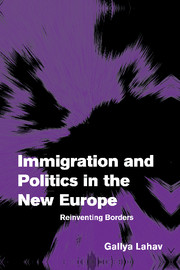Book contents
- Frontmatter
- Contents
- List of figures and tables
- Preface and acknowledgments
- 1 Introduction
- 2 Toward a people's Europe: an institutional analysis of immigration policy in the European Union
- 3 An attitudinal portrait of a people's Europe: a comparative overview of public opinion and elite preferences
- 4 Immigration politics and the new Europe: organizing competing interests
- 5 The “European factor”: institutional and psychological constraints on immigration attitudes
- 6 Conclusions: the construction of a European immigration regime?
- Appendices
- Bibliography
- Index
3 - An attitudinal portrait of a people's Europe: a comparative overview of public opinion and elite preferences
Published online by Cambridge University Press: 18 December 2009
- Frontmatter
- Contents
- List of figures and tables
- Preface and acknowledgments
- 1 Introduction
- 2 Toward a people's Europe: an institutional analysis of immigration policy in the European Union
- 3 An attitudinal portrait of a people's Europe: a comparative overview of public opinion and elite preferences
- 4 Immigration politics and the new Europe: organizing competing interests
- 5 The “European factor”: institutional and psychological constraints on immigration attitudes
- 6 Conclusions: the construction of a European immigration regime?
- Appendices
- Bibliography
- Index
Summary
Act III, Scene 1: Human nature does not change, but when nations and men accept the same rule and the same institutions to make sure that they are applied, their behavior toward each other changes. This is the process of civilization itself.
(Jean Monnet, “A Ferment of Change” 1962: 211.)Scene 2: The discussion chamber was reverberating with procedures and rules – not all of which appeared so evident to the deputies. Perhaps over time, these manmade procedures will inculcate a universal mindset about immigration itself. Or, maybe, the difficulty in getting beyond technical issues is a reflection of persistent conflicting norms.
(Diary of researcher, Strasbourg, June 9, 1992.)According to the official EU mantra, the ultimate aim of the “Community” has been to establish “an ever closer union among the European peoples” (the preamble of the Rome Treaty, the first “constitution” establishing the Community). As with all shared views about Europe, there are many diverse opinions on how to achieve this goal. Nonetheless, its implications, particularly for an immigration regime, are significant. This is because the question of a people's Europe hinges on who those people are, and what to do about the “outsiders” among them.
The basic principle underlying “a people's Europe” relates to the human dimension of the Union – the idea that Community citizenship, irrespective of nationality, bestows the same rights, freedoms, and obligations for all member-state nationals. The concept of European citizenship stresses the universality of human rights throughout the Union.
- Type
- Chapter
- Information
- Immigration and Politics in the New EuropeReinventing Borders, pp. 69 - 112Publisher: Cambridge University PressPrint publication year: 2004



